Analysis Report: Working and Leading People in Morrison Retail Sector
VerifiedAdded on 2020/01/28
|18
|6257
|60
Report
AI Summary
This report provides a comprehensive analysis of working with and leading people, focusing on the retail sector, specifically using Morrison as a case study. The report begins by outlining the process of recruiting and selecting new employees, including the preparation of necessary documentation, assessment of legal and ethical considerations, and an analysis of the general manager's role in the selection process. It then delves into the skills and attributes of effective managers and leaders, differentiating between managerial and leadership skills and comparing various leadership styles. The report also assesses the benefits of teamwork, demonstrates conflict resolution strategies, and reviews methods for enhancing team effectiveness. Further, it explores the factors involved in planning, monitoring, and assessing employee performance, including the planning and delivery of employee development assessments and an evaluation of their success within the organization. The study highlights the importance of legal compliance, ethical considerations, and the impact of various management practices on organizational success.
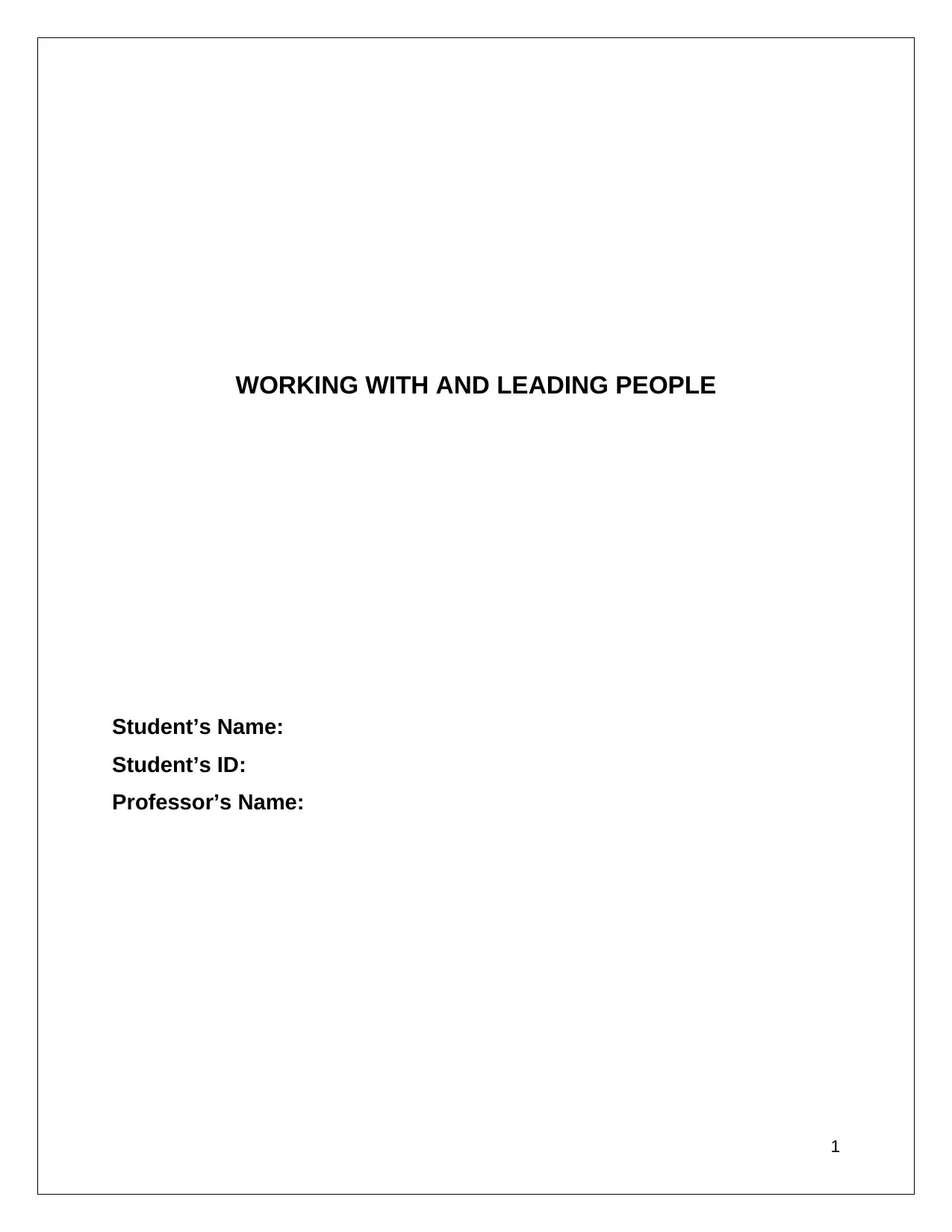
WORKING WITH AND LEADING PEOPLE
Student’s Name:
Student’s ID:
Professor’s Name:
1
Student’s Name:
Student’s ID:
Professor’s Name:
1
Paraphrase This Document
Need a fresh take? Get an instant paraphrase of this document with our AI Paraphraser
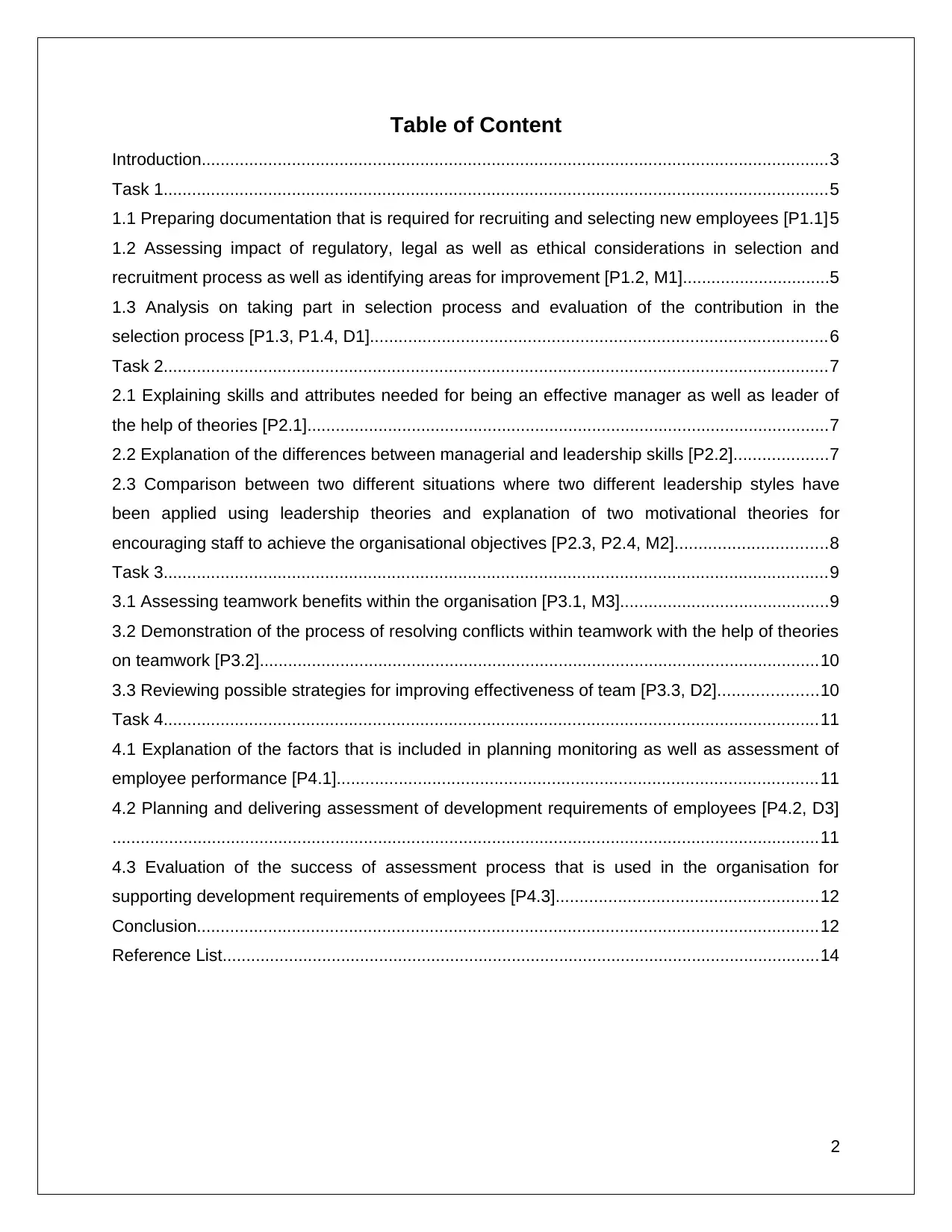
Table of Content
Introduction....................................................................................................................................3
Task 1............................................................................................................................................5
1.1 Preparing documentation that is required for recruiting and selecting new employees [P1.1]5
1.2 Assessing impact of regulatory, legal as well as ethical considerations in selection and
recruitment process as well as identifying areas for improvement [P1.2, M1]...............................5
1.3 Analysis on taking part in selection process and evaluation of the contribution in the
selection process [P1.3, P1.4, D1]................................................................................................6
Task 2............................................................................................................................................7
2.1 Explaining skills and attributes needed for being an effective manager as well as leader of
the help of theories [P2.1]..............................................................................................................7
2.2 Explanation of the differences between managerial and leadership skills [P2.2]....................7
2.3 Comparison between two different situations where two different leadership styles have
been applied using leadership theories and explanation of two motivational theories for
encouraging staff to achieve the organisational objectives [P2.3, P2.4, M2]................................8
Task 3............................................................................................................................................9
3.1 Assessing teamwork benefits within the organisation [P3.1, M3]............................................9
3.2 Demonstration of the process of resolving conflicts within teamwork with the help of theories
on teamwork [P3.2]......................................................................................................................10
3.3 Reviewing possible strategies for improving effectiveness of team [P3.3, D2].....................10
Task 4..........................................................................................................................................11
4.1 Explanation of the factors that is included in planning monitoring as well as assessment of
employee performance [P4.1].....................................................................................................11
4.2 Planning and delivering assessment of development requirements of employees [P4.2, D3]
.....................................................................................................................................................11
4.3 Evaluation of the success of assessment process that is used in the organisation for
supporting development requirements of employees [P4.3].......................................................12
Conclusion...................................................................................................................................12
Reference List..............................................................................................................................14
2
Introduction....................................................................................................................................3
Task 1............................................................................................................................................5
1.1 Preparing documentation that is required for recruiting and selecting new employees [P1.1]5
1.2 Assessing impact of regulatory, legal as well as ethical considerations in selection and
recruitment process as well as identifying areas for improvement [P1.2, M1]...............................5
1.3 Analysis on taking part in selection process and evaluation of the contribution in the
selection process [P1.3, P1.4, D1]................................................................................................6
Task 2............................................................................................................................................7
2.1 Explaining skills and attributes needed for being an effective manager as well as leader of
the help of theories [P2.1]..............................................................................................................7
2.2 Explanation of the differences between managerial and leadership skills [P2.2]....................7
2.3 Comparison between two different situations where two different leadership styles have
been applied using leadership theories and explanation of two motivational theories for
encouraging staff to achieve the organisational objectives [P2.3, P2.4, M2]................................8
Task 3............................................................................................................................................9
3.1 Assessing teamwork benefits within the organisation [P3.1, M3]............................................9
3.2 Demonstration of the process of resolving conflicts within teamwork with the help of theories
on teamwork [P3.2]......................................................................................................................10
3.3 Reviewing possible strategies for improving effectiveness of team [P3.3, D2].....................10
Task 4..........................................................................................................................................11
4.1 Explanation of the factors that is included in planning monitoring as well as assessment of
employee performance [P4.1].....................................................................................................11
4.2 Planning and delivering assessment of development requirements of employees [P4.2, D3]
.....................................................................................................................................................11
4.3 Evaluation of the success of assessment process that is used in the organisation for
supporting development requirements of employees [P4.3].......................................................12
Conclusion...................................................................................................................................12
Reference List..............................................................................................................................14
2
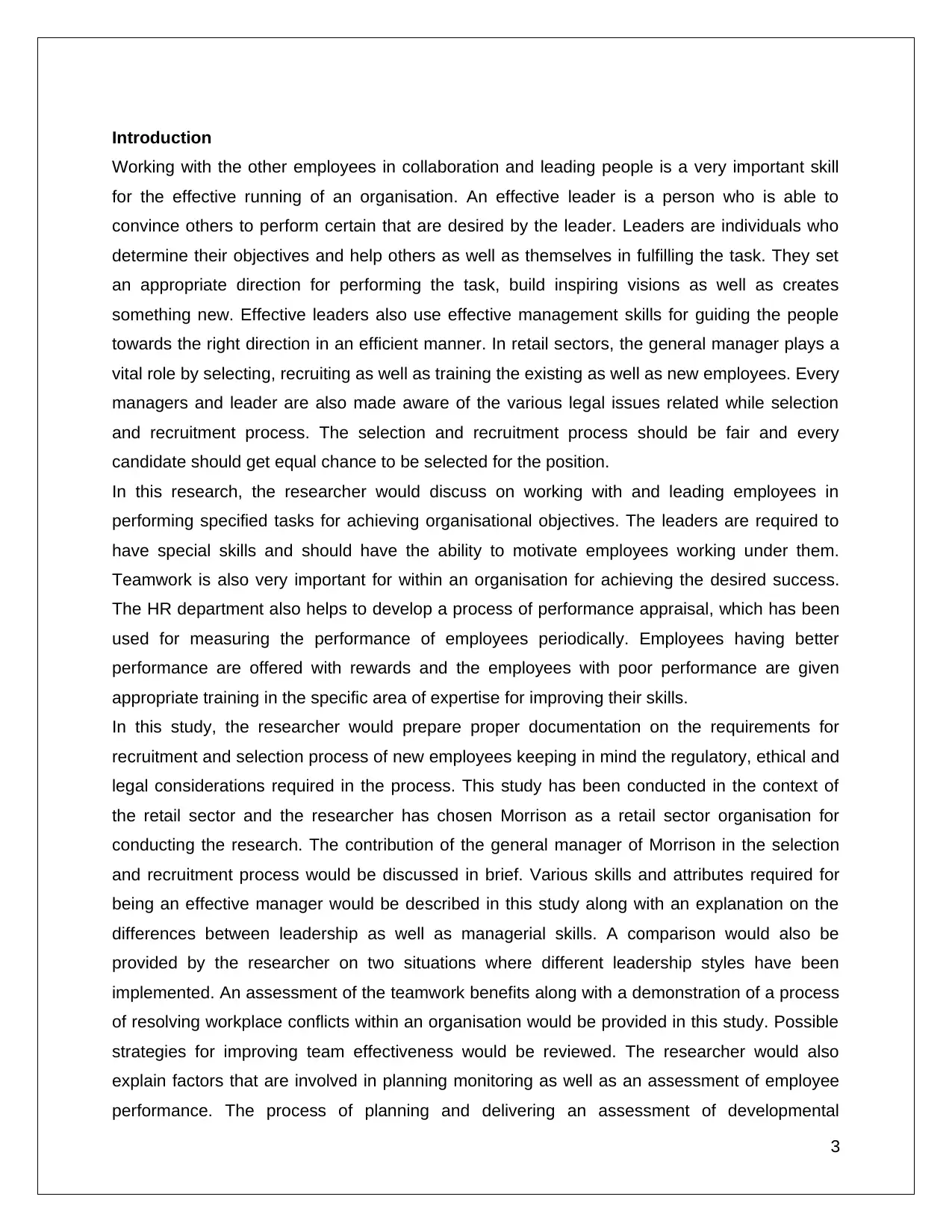
Introduction
Working with the other employees in collaboration and leading people is a very important skill
for the effective running of an organisation. An effective leader is a person who is able to
convince others to perform certain that are desired by the leader. Leaders are individuals who
determine their objectives and help others as well as themselves in fulfilling the task. They set
an appropriate direction for performing the task, build inspiring visions as well as creates
something new. Effective leaders also use effective management skills for guiding the people
towards the right direction in an efficient manner. In retail sectors, the general manager plays a
vital role by selecting, recruiting as well as training the existing as well as new employees. Every
managers and leader are also made aware of the various legal issues related while selection
and recruitment process. The selection and recruitment process should be fair and every
candidate should get equal chance to be selected for the position.
In this research, the researcher would discuss on working with and leading employees in
performing specified tasks for achieving organisational objectives. The leaders are required to
have special skills and should have the ability to motivate employees working under them.
Teamwork is also very important for within an organisation for achieving the desired success.
The HR department also helps to develop a process of performance appraisal, which has been
used for measuring the performance of employees periodically. Employees having better
performance are offered with rewards and the employees with poor performance are given
appropriate training in the specific area of expertise for improving their skills.
In this study, the researcher would prepare proper documentation on the requirements for
recruitment and selection process of new employees keeping in mind the regulatory, ethical and
legal considerations required in the process. This study has been conducted in the context of
the retail sector and the researcher has chosen Morrison as a retail sector organisation for
conducting the research. The contribution of the general manager of Morrison in the selection
and recruitment process would be discussed in brief. Various skills and attributes required for
being an effective manager would be described in this study along with an explanation on the
differences between leadership as well as managerial skills. A comparison would also be
provided by the researcher on two situations where different leadership styles have been
implemented. An assessment of the teamwork benefits along with a demonstration of a process
of resolving workplace conflicts within an organisation would be provided in this study. Possible
strategies for improving team effectiveness would be reviewed. The researcher would also
explain factors that are involved in planning monitoring as well as an assessment of employee
performance. The process of planning and delivering an assessment of developmental
3
Working with the other employees in collaboration and leading people is a very important skill
for the effective running of an organisation. An effective leader is a person who is able to
convince others to perform certain that are desired by the leader. Leaders are individuals who
determine their objectives and help others as well as themselves in fulfilling the task. They set
an appropriate direction for performing the task, build inspiring visions as well as creates
something new. Effective leaders also use effective management skills for guiding the people
towards the right direction in an efficient manner. In retail sectors, the general manager plays a
vital role by selecting, recruiting as well as training the existing as well as new employees. Every
managers and leader are also made aware of the various legal issues related while selection
and recruitment process. The selection and recruitment process should be fair and every
candidate should get equal chance to be selected for the position.
In this research, the researcher would discuss on working with and leading employees in
performing specified tasks for achieving organisational objectives. The leaders are required to
have special skills and should have the ability to motivate employees working under them.
Teamwork is also very important for within an organisation for achieving the desired success.
The HR department also helps to develop a process of performance appraisal, which has been
used for measuring the performance of employees periodically. Employees having better
performance are offered with rewards and the employees with poor performance are given
appropriate training in the specific area of expertise for improving their skills.
In this study, the researcher would prepare proper documentation on the requirements for
recruitment and selection process of new employees keeping in mind the regulatory, ethical and
legal considerations required in the process. This study has been conducted in the context of
the retail sector and the researcher has chosen Morrison as a retail sector organisation for
conducting the research. The contribution of the general manager of Morrison in the selection
and recruitment process would be discussed in brief. Various skills and attributes required for
being an effective manager would be described in this study along with an explanation on the
differences between leadership as well as managerial skills. A comparison would also be
provided by the researcher on two situations where different leadership styles have been
implemented. An assessment of the teamwork benefits along with a demonstration of a process
of resolving workplace conflicts within an organisation would be provided in this study. Possible
strategies for improving team effectiveness would be reviewed. The researcher would also
explain factors that are involved in planning monitoring as well as an assessment of employee
performance. The process of planning and delivering an assessment of developmental
3
⊘ This is a preview!⊘
Do you want full access?
Subscribe today to unlock all pages.

Trusted by 1+ million students worldwide
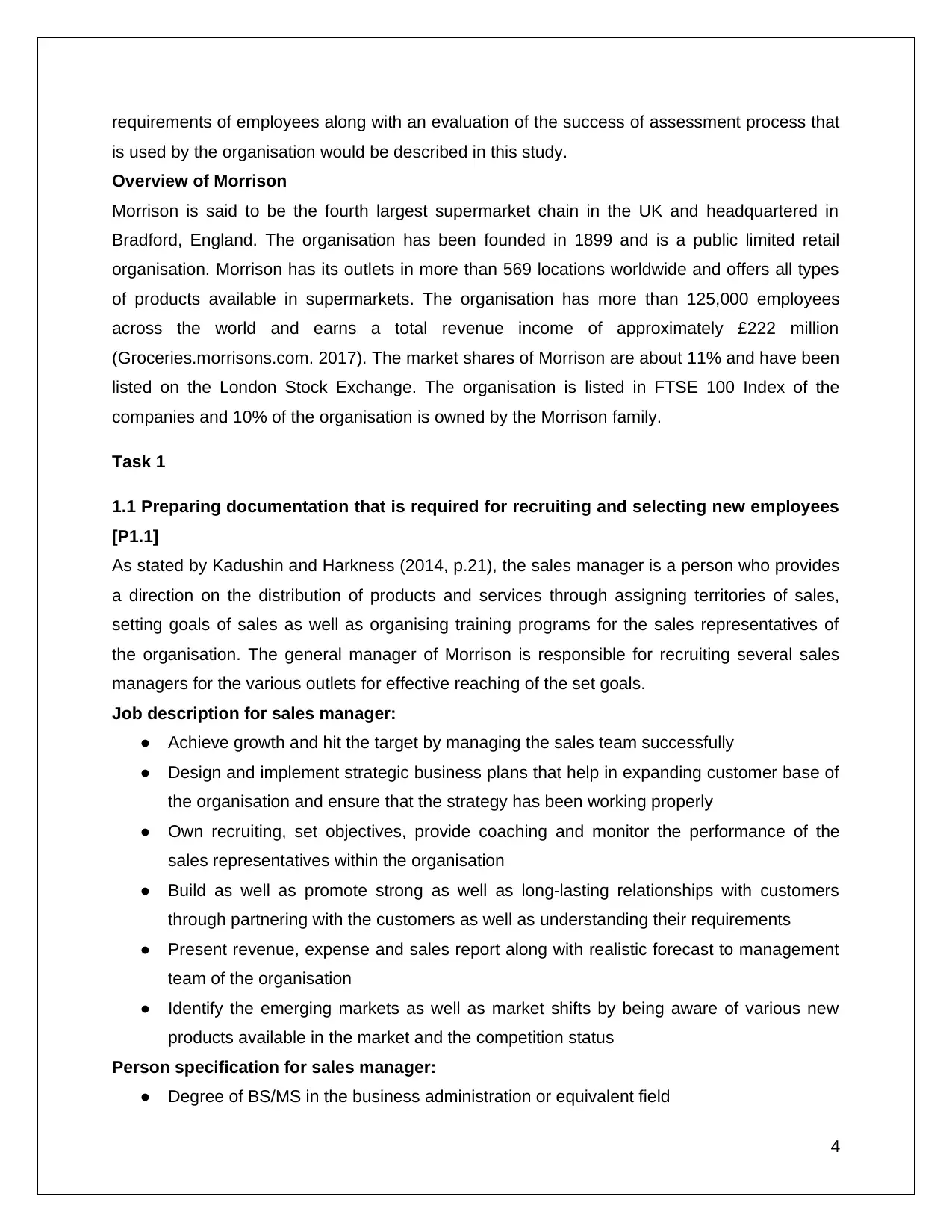
requirements of employees along with an evaluation of the success of assessment process that
is used by the organisation would be described in this study.
Overview of Morrison
Morrison is said to be the fourth largest supermarket chain in the UK and headquartered in
Bradford, England. The organisation has been founded in 1899 and is a public limited retail
organisation. Morrison has its outlets in more than 569 locations worldwide and offers all types
of products available in supermarkets. The organisation has more than 125,000 employees
across the world and earns a total revenue income of approximately £222 million
(Groceries.morrisons.com. 2017). The market shares of Morrison are about 11% and have been
listed on the London Stock Exchange. The organisation is listed in FTSE 100 Index of the
companies and 10% of the organisation is owned by the Morrison family.
Task 1
1.1 Preparing documentation that is required for recruiting and selecting new employees
[P1.1]
As stated by Kadushin and Harkness (2014, p.21), the sales manager is a person who provides
a direction on the distribution of products and services through assigning territories of sales,
setting goals of sales as well as organising training programs for the sales representatives of
the organisation. The general manager of Morrison is responsible for recruiting several sales
managers for the various outlets for effective reaching of the set goals.
Job description for sales manager:
● Achieve growth and hit the target by managing the sales team successfully
● Design and implement strategic business plans that help in expanding customer base of
the organisation and ensure that the strategy has been working properly
● Own recruiting, set objectives, provide coaching and monitor the performance of the
sales representatives within the organisation
● Build as well as promote strong as well as long-lasting relationships with customers
through partnering with the customers as well as understanding their requirements
● Present revenue, expense and sales report along with realistic forecast to management
team of the organisation
● Identify the emerging markets as well as market shifts by being aware of various new
products available in the market and the competition status
Person specification for sales manager:
● Degree of BS/MS in the business administration or equivalent field
4
is used by the organisation would be described in this study.
Overview of Morrison
Morrison is said to be the fourth largest supermarket chain in the UK and headquartered in
Bradford, England. The organisation has been founded in 1899 and is a public limited retail
organisation. Morrison has its outlets in more than 569 locations worldwide and offers all types
of products available in supermarkets. The organisation has more than 125,000 employees
across the world and earns a total revenue income of approximately £222 million
(Groceries.morrisons.com. 2017). The market shares of Morrison are about 11% and have been
listed on the London Stock Exchange. The organisation is listed in FTSE 100 Index of the
companies and 10% of the organisation is owned by the Morrison family.
Task 1
1.1 Preparing documentation that is required for recruiting and selecting new employees
[P1.1]
As stated by Kadushin and Harkness (2014, p.21), the sales manager is a person who provides
a direction on the distribution of products and services through assigning territories of sales,
setting goals of sales as well as organising training programs for the sales representatives of
the organisation. The general manager of Morrison is responsible for recruiting several sales
managers for the various outlets for effective reaching of the set goals.
Job description for sales manager:
● Achieve growth and hit the target by managing the sales team successfully
● Design and implement strategic business plans that help in expanding customer base of
the organisation and ensure that the strategy has been working properly
● Own recruiting, set objectives, provide coaching and monitor the performance of the
sales representatives within the organisation
● Build as well as promote strong as well as long-lasting relationships with customers
through partnering with the customers as well as understanding their requirements
● Present revenue, expense and sales report along with realistic forecast to management
team of the organisation
● Identify the emerging markets as well as market shifts by being aware of various new
products available in the market and the competition status
Person specification for sales manager:
● Degree of BS/MS in the business administration or equivalent field
4
Paraphrase This Document
Need a fresh take? Get an instant paraphrase of this document with our AI Paraphraser
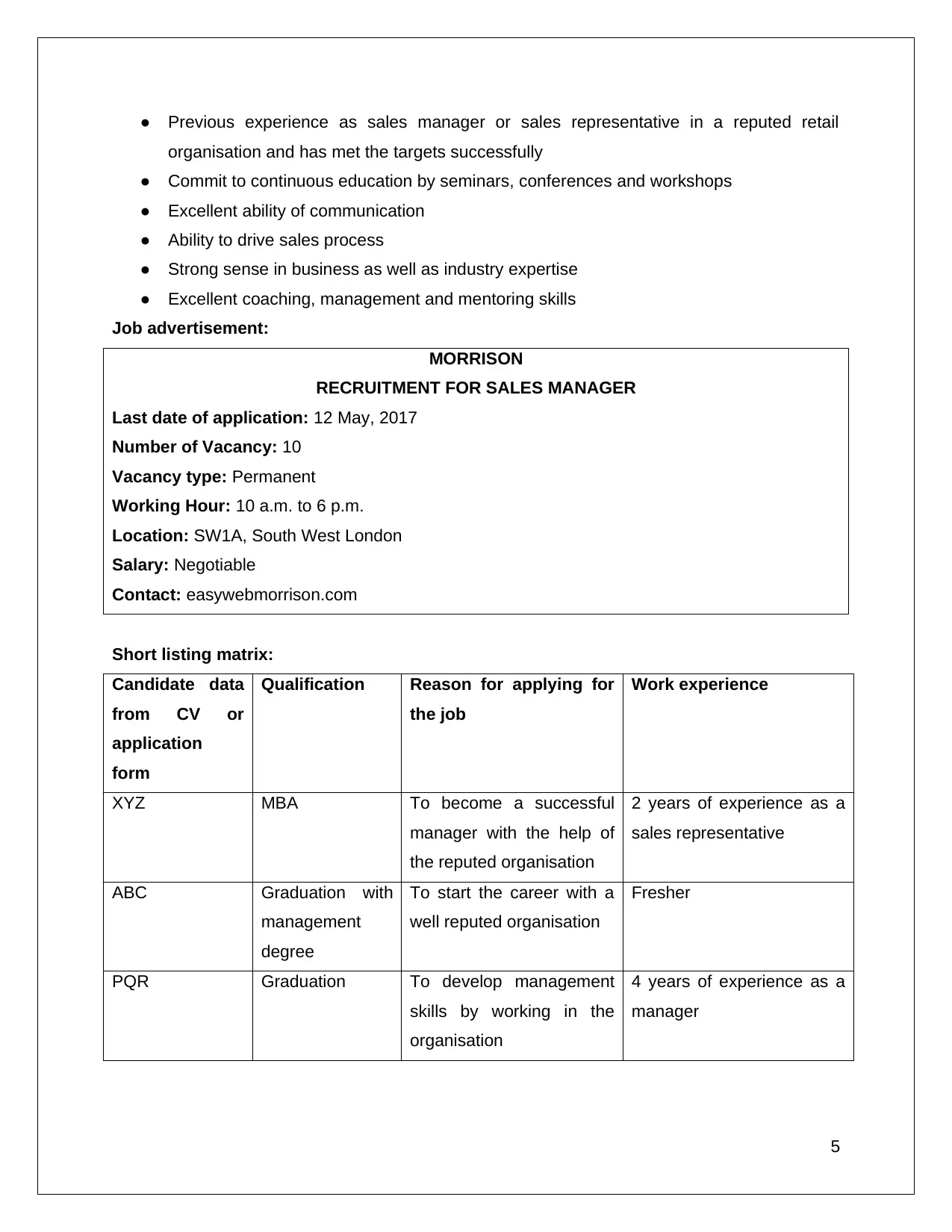
● Previous experience as sales manager or sales representative in a reputed retail
organisation and has met the targets successfully
● Commit to continuous education by seminars, conferences and workshops
● Excellent ability of communication
● Ability to drive sales process
● Strong sense in business as well as industry expertise
● Excellent coaching, management and mentoring skills
Job advertisement:
MORRISON
RECRUITMENT FOR SALES MANAGER
Last date of application: 12 May, 2017
Number of Vacancy: 10
Vacancy type: Permanent
Working Hour: 10 a.m. to 6 p.m.
Location: SW1A, South West London
Salary: Negotiable
Contact: easywebmorrison.com
Short listing matrix:
Candidate data
from CV or
application
form
Qualification Reason for applying for
the job
Work experience
XYZ MBA To become a successful
manager with the help of
the reputed organisation
2 years of experience as a
sales representative
ABC Graduation with
management
degree
To start the career with a
well reputed organisation
Fresher
PQR Graduation To develop management
skills by working in the
organisation
4 years of experience as a
manager
5
organisation and has met the targets successfully
● Commit to continuous education by seminars, conferences and workshops
● Excellent ability of communication
● Ability to drive sales process
● Strong sense in business as well as industry expertise
● Excellent coaching, management and mentoring skills
Job advertisement:
MORRISON
RECRUITMENT FOR SALES MANAGER
Last date of application: 12 May, 2017
Number of Vacancy: 10
Vacancy type: Permanent
Working Hour: 10 a.m. to 6 p.m.
Location: SW1A, South West London
Salary: Negotiable
Contact: easywebmorrison.com
Short listing matrix:
Candidate data
from CV or
application
form
Qualification Reason for applying for
the job
Work experience
XYZ MBA To become a successful
manager with the help of
the reputed organisation
2 years of experience as a
sales representative
ABC Graduation with
management
degree
To start the career with a
well reputed organisation
Fresher
PQR Graduation To develop management
skills by working in the
organisation
4 years of experience as a
manager
5
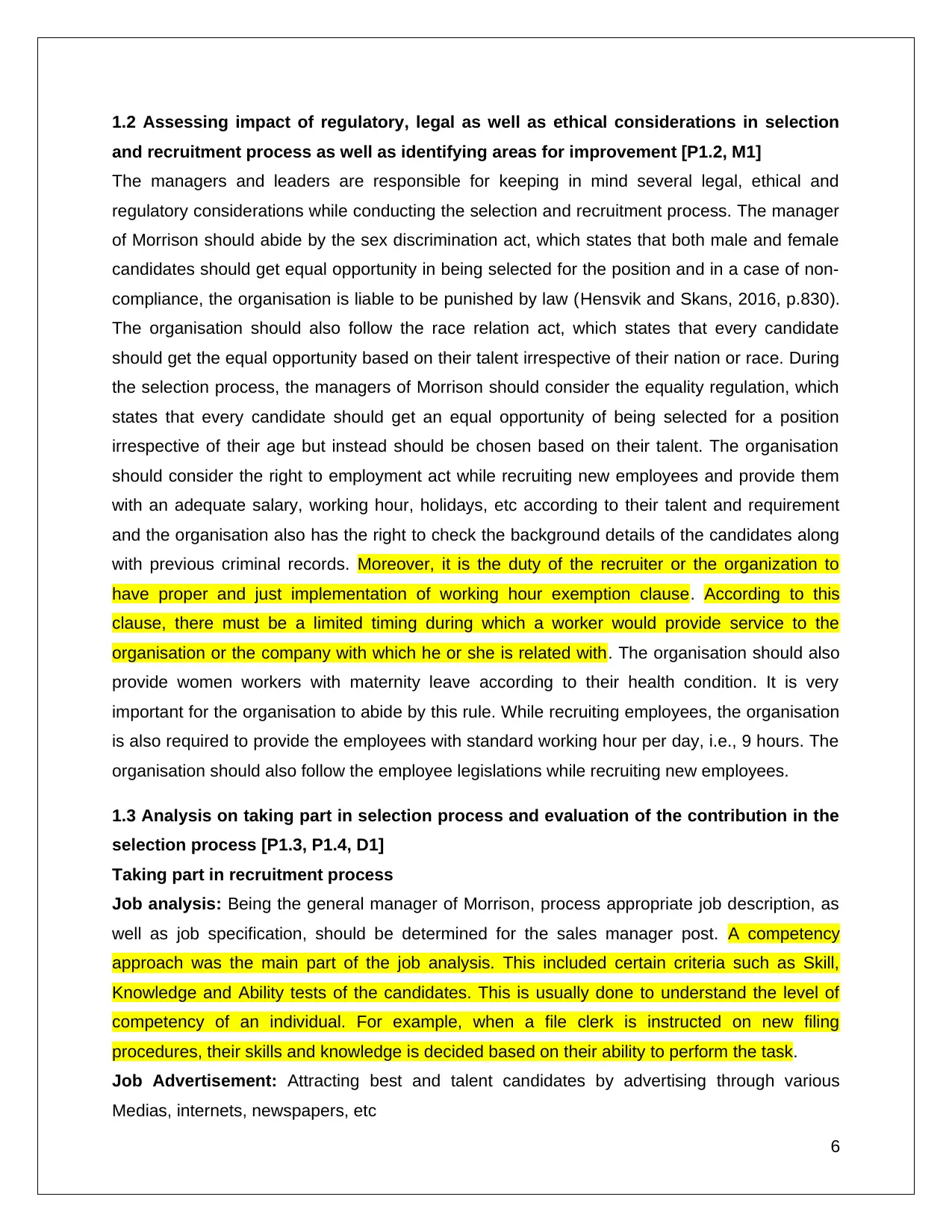
1.2 Assessing impact of regulatory, legal as well as ethical considerations in selection
and recruitment process as well as identifying areas for improvement [P1.2, M1]
The managers and leaders are responsible for keeping in mind several legal, ethical and
regulatory considerations while conducting the selection and recruitment process. The manager
of Morrison should abide by the sex discrimination act, which states that both male and female
candidates should get equal opportunity in being selected for the position and in a case of non-
compliance, the organisation is liable to be punished by law (Hensvik and Skans, 2016, p.830).
The organisation should also follow the race relation act, which states that every candidate
should get the equal opportunity based on their talent irrespective of their nation or race. During
the selection process, the managers of Morrison should consider the equality regulation, which
states that every candidate should get an equal opportunity of being selected for a position
irrespective of their age but instead should be chosen based on their talent. The organisation
should consider the right to employment act while recruiting new employees and provide them
with an adequate salary, working hour, holidays, etc according to their talent and requirement
and the organisation also has the right to check the background details of the candidates along
with previous criminal records. Moreover, it is the duty of the recruiter or the organization to
have proper and just implementation of working hour exemption clause. According to this
clause, there must be a limited timing during which a worker would provide service to the
organisation or the company with which he or she is related with. The organisation should also
provide women workers with maternity leave according to their health condition. It is very
important for the organisation to abide by this rule. While recruiting employees, the organisation
is also required to provide the employees with standard working hour per day, i.e., 9 hours. The
organisation should also follow the employee legislations while recruiting new employees.
1.3 Analysis on taking part in selection process and evaluation of the contribution in the
selection process [P1.3, P1.4, D1]
Taking part in recruitment process
Job analysis: Being the general manager of Morrison, process appropriate job description, as
well as job specification, should be determined for the sales manager post. A competency
approach was the main part of the job analysis. This included certain criteria such as Skill,
Knowledge and Ability tests of the candidates. This is usually done to understand the level of
competency of an individual. For example, when a file clerk is instructed on new filing
procedures, their skills and knowledge is decided based on their ability to perform the task.
Job Advertisement: Attracting best and talent candidates by advertising through various
Medias, internets, newspapers, etc
6
and recruitment process as well as identifying areas for improvement [P1.2, M1]
The managers and leaders are responsible for keeping in mind several legal, ethical and
regulatory considerations while conducting the selection and recruitment process. The manager
of Morrison should abide by the sex discrimination act, which states that both male and female
candidates should get equal opportunity in being selected for the position and in a case of non-
compliance, the organisation is liable to be punished by law (Hensvik and Skans, 2016, p.830).
The organisation should also follow the race relation act, which states that every candidate
should get the equal opportunity based on their talent irrespective of their nation or race. During
the selection process, the managers of Morrison should consider the equality regulation, which
states that every candidate should get an equal opportunity of being selected for a position
irrespective of their age but instead should be chosen based on their talent. The organisation
should consider the right to employment act while recruiting new employees and provide them
with an adequate salary, working hour, holidays, etc according to their talent and requirement
and the organisation also has the right to check the background details of the candidates along
with previous criminal records. Moreover, it is the duty of the recruiter or the organization to
have proper and just implementation of working hour exemption clause. According to this
clause, there must be a limited timing during which a worker would provide service to the
organisation or the company with which he or she is related with. The organisation should also
provide women workers with maternity leave according to their health condition. It is very
important for the organisation to abide by this rule. While recruiting employees, the organisation
is also required to provide the employees with standard working hour per day, i.e., 9 hours. The
organisation should also follow the employee legislations while recruiting new employees.
1.3 Analysis on taking part in selection process and evaluation of the contribution in the
selection process [P1.3, P1.4, D1]
Taking part in recruitment process
Job analysis: Being the general manager of Morrison, process appropriate job description, as
well as job specification, should be determined for the sales manager post. A competency
approach was the main part of the job analysis. This included certain criteria such as Skill,
Knowledge and Ability tests of the candidates. This is usually done to understand the level of
competency of an individual. For example, when a file clerk is instructed on new filing
procedures, their skills and knowledge is decided based on their ability to perform the task.
Job Advertisement: Attracting best and talent candidates by advertising through various
Medias, internets, newspapers, etc
6
⊘ This is a preview!⊘
Do you want full access?
Subscribe today to unlock all pages.

Trusted by 1+ million students worldwide
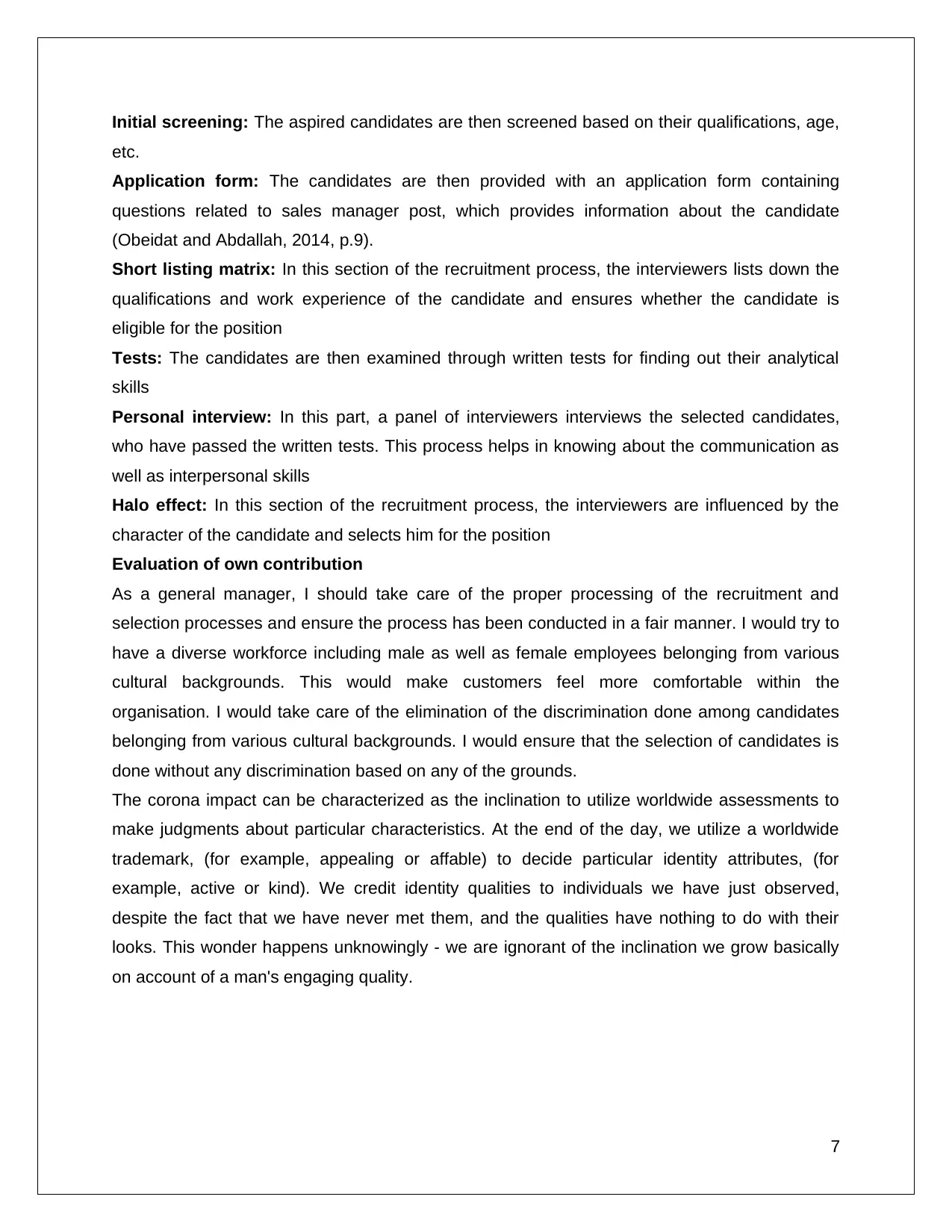
Initial screening: The aspired candidates are then screened based on their qualifications, age,
etc.
Application form: The candidates are then provided with an application form containing
questions related to sales manager post, which provides information about the candidate
(Obeidat and Abdallah, 2014, p.9).
Short listing matrix: In this section of the recruitment process, the interviewers lists down the
qualifications and work experience of the candidate and ensures whether the candidate is
eligible for the position
Tests: The candidates are then examined through written tests for finding out their analytical
skills
Personal interview: In this part, a panel of interviewers interviews the selected candidates,
who have passed the written tests. This process helps in knowing about the communication as
well as interpersonal skills
Halo effect: In this section of the recruitment process, the interviewers are influenced by the
character of the candidate and selects him for the position
Evaluation of own contribution
As a general manager, I should take care of the proper processing of the recruitment and
selection processes and ensure the process has been conducted in a fair manner. I would try to
have a diverse workforce including male as well as female employees belonging from various
cultural backgrounds. This would make customers feel more comfortable within the
organisation. I would take care of the elimination of the discrimination done among candidates
belonging from various cultural backgrounds. I would ensure that the selection of candidates is
done without any discrimination based on any of the grounds.
The corona impact can be characterized as the inclination to utilize worldwide assessments to
make judgments about particular characteristics. At the end of the day, we utilize a worldwide
trademark, (for example, appealing or affable) to decide particular identity attributes, (for
example, active or kind). We credit identity qualities to individuals we have just observed,
despite the fact that we have never met them, and the qualities have nothing to do with their
looks. This wonder happens unknowingly - we are ignorant of the inclination we grow basically
on account of a man's engaging quality.
7
etc.
Application form: The candidates are then provided with an application form containing
questions related to sales manager post, which provides information about the candidate
(Obeidat and Abdallah, 2014, p.9).
Short listing matrix: In this section of the recruitment process, the interviewers lists down the
qualifications and work experience of the candidate and ensures whether the candidate is
eligible for the position
Tests: The candidates are then examined through written tests for finding out their analytical
skills
Personal interview: In this part, a panel of interviewers interviews the selected candidates,
who have passed the written tests. This process helps in knowing about the communication as
well as interpersonal skills
Halo effect: In this section of the recruitment process, the interviewers are influenced by the
character of the candidate and selects him for the position
Evaluation of own contribution
As a general manager, I should take care of the proper processing of the recruitment and
selection processes and ensure the process has been conducted in a fair manner. I would try to
have a diverse workforce including male as well as female employees belonging from various
cultural backgrounds. This would make customers feel more comfortable within the
organisation. I would take care of the elimination of the discrimination done among candidates
belonging from various cultural backgrounds. I would ensure that the selection of candidates is
done without any discrimination based on any of the grounds.
The corona impact can be characterized as the inclination to utilize worldwide assessments to
make judgments about particular characteristics. At the end of the day, we utilize a worldwide
trademark, (for example, appealing or affable) to decide particular identity attributes, (for
example, active or kind). We credit identity qualities to individuals we have just observed,
despite the fact that we have never met them, and the qualities have nothing to do with their
looks. This wonder happens unknowingly - we are ignorant of the inclination we grow basically
on account of a man's engaging quality.
7
Paraphrase This Document
Need a fresh take? Get an instant paraphrase of this document with our AI Paraphraser
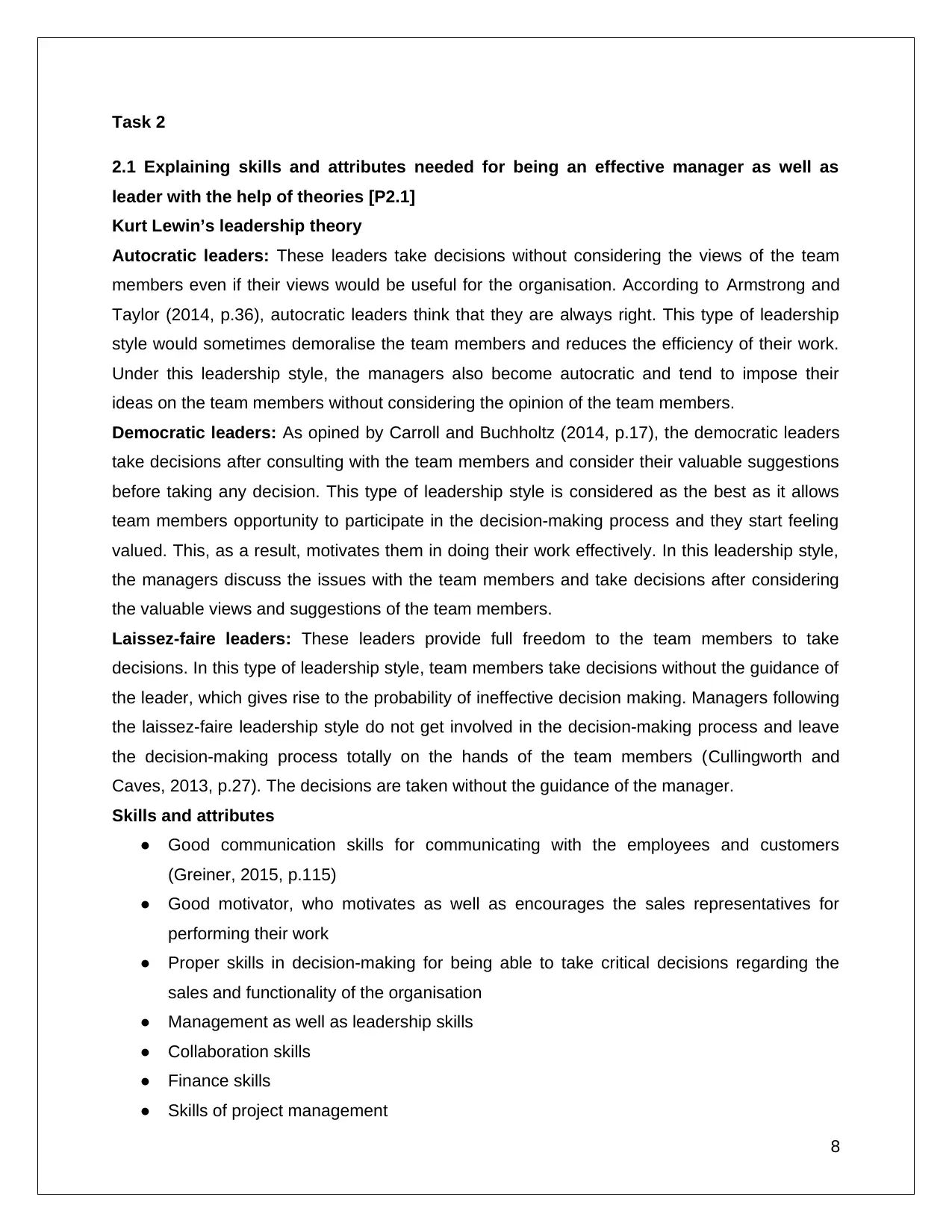
Task 2
2.1 Explaining skills and attributes needed for being an effective manager as well as
leader with the help of theories [P2.1]
Kurt Lewin’s leadership theory
Autocratic leaders: These leaders take decisions without considering the views of the team
members even if their views would be useful for the organisation. According to Armstrong and
Taylor (2014, p.36), autocratic leaders think that they are always right. This type of leadership
style would sometimes demoralise the team members and reduces the efficiency of their work.
Under this leadership style, the managers also become autocratic and tend to impose their
ideas on the team members without considering the opinion of the team members.
Democratic leaders: As opined by Carroll and Buchholtz (2014, p.17), the democratic leaders
take decisions after consulting with the team members and consider their valuable suggestions
before taking any decision. This type of leadership style is considered as the best as it allows
team members opportunity to participate in the decision-making process and they start feeling
valued. This, as a result, motivates them in doing their work effectively. In this leadership style,
the managers discuss the issues with the team members and take decisions after considering
the valuable views and suggestions of the team members.
Laissez-faire leaders: These leaders provide full freedom to the team members to take
decisions. In this type of leadership style, team members take decisions without the guidance of
the leader, which gives rise to the probability of ineffective decision making. Managers following
the laissez-faire leadership style do not get involved in the decision-making process and leave
the decision-making process totally on the hands of the team members (Cullingworth and
Caves, 2013, p.27). The decisions are taken without the guidance of the manager.
Skills and attributes
● Good communication skills for communicating with the employees and customers
(Greiner, 2015, p.115)
● Good motivator, who motivates as well as encourages the sales representatives for
performing their work
● Proper skills in decision-making for being able to take critical decisions regarding the
sales and functionality of the organisation
● Management as well as leadership skills
● Collaboration skills
● Finance skills
● Skills of project management
8
2.1 Explaining skills and attributes needed for being an effective manager as well as
leader with the help of theories [P2.1]
Kurt Lewin’s leadership theory
Autocratic leaders: These leaders take decisions without considering the views of the team
members even if their views would be useful for the organisation. According to Armstrong and
Taylor (2014, p.36), autocratic leaders think that they are always right. This type of leadership
style would sometimes demoralise the team members and reduces the efficiency of their work.
Under this leadership style, the managers also become autocratic and tend to impose their
ideas on the team members without considering the opinion of the team members.
Democratic leaders: As opined by Carroll and Buchholtz (2014, p.17), the democratic leaders
take decisions after consulting with the team members and consider their valuable suggestions
before taking any decision. This type of leadership style is considered as the best as it allows
team members opportunity to participate in the decision-making process and they start feeling
valued. This, as a result, motivates them in doing their work effectively. In this leadership style,
the managers discuss the issues with the team members and take decisions after considering
the valuable views and suggestions of the team members.
Laissez-faire leaders: These leaders provide full freedom to the team members to take
decisions. In this type of leadership style, team members take decisions without the guidance of
the leader, which gives rise to the probability of ineffective decision making. Managers following
the laissez-faire leadership style do not get involved in the decision-making process and leave
the decision-making process totally on the hands of the team members (Cullingworth and
Caves, 2013, p.27). The decisions are taken without the guidance of the manager.
Skills and attributes
● Good communication skills for communicating with the employees and customers
(Greiner, 2015, p.115)
● Good motivator, who motivates as well as encourages the sales representatives for
performing their work
● Proper skills in decision-making for being able to take critical decisions regarding the
sales and functionality of the organisation
● Management as well as leadership skills
● Collaboration skills
● Finance skills
● Skills of project management
8
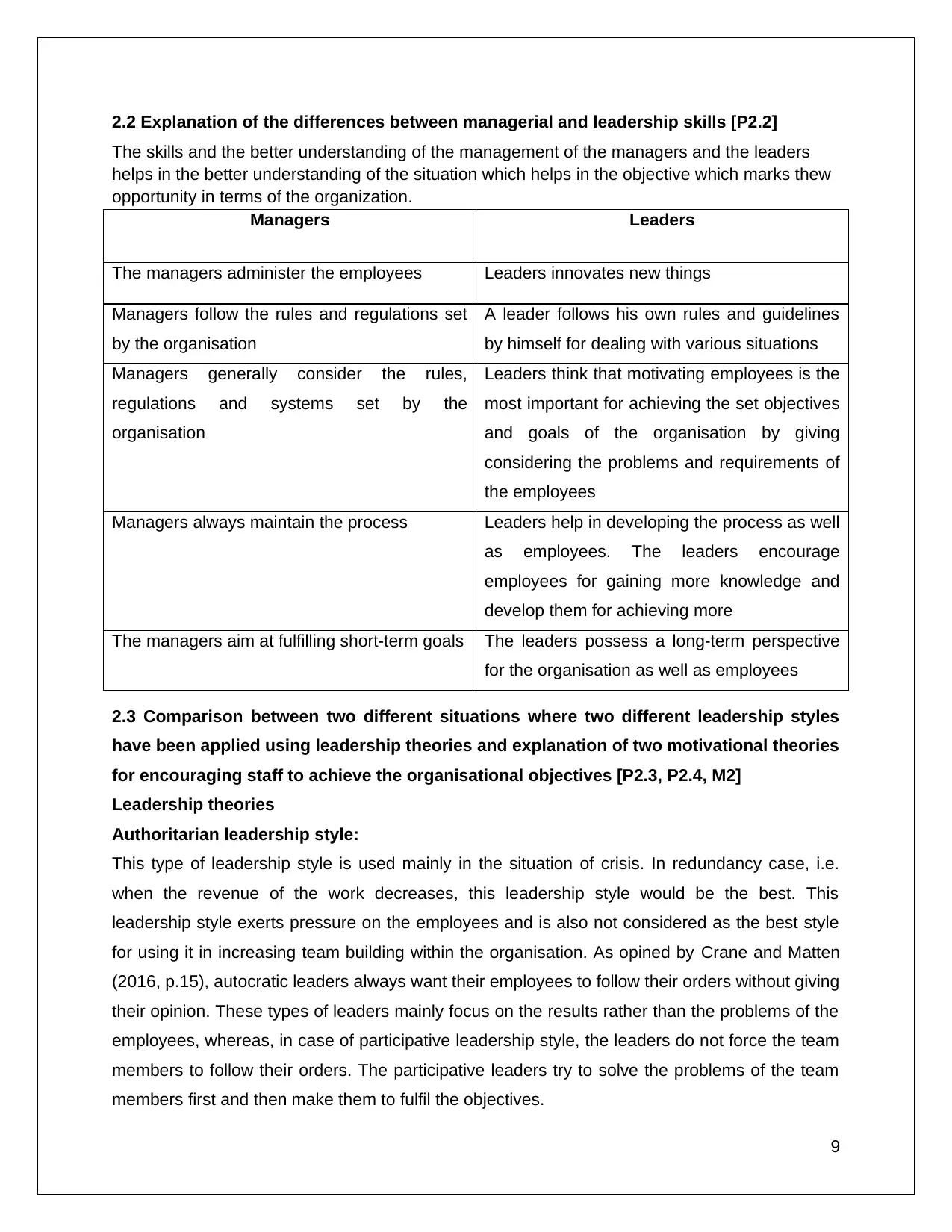
2.2 Explanation of the differences between managerial and leadership skills [P2.2]
The skills and the better understanding of the management of the managers and the leaders
helps in the better understanding of the situation which helps in the objective which marks thew
opportunity in terms of the organization.
Managers Leaders
The managers administer the employees Leaders innovates new things
Managers follow the rules and regulations set
by the organisation
A leader follows his own rules and guidelines
by himself for dealing with various situations
Managers generally consider the rules,
regulations and systems set by the
organisation
Leaders think that motivating employees is the
most important for achieving the set objectives
and goals of the organisation by giving
considering the problems and requirements of
the employees
Managers always maintain the process Leaders help in developing the process as well
as employees. The leaders encourage
employees for gaining more knowledge and
develop them for achieving more
The managers aim at fulfilling short-term goals The leaders possess a long-term perspective
for the organisation as well as employees
2.3 Comparison between two different situations where two different leadership styles
have been applied using leadership theories and explanation of two motivational theories
for encouraging staff to achieve the organisational objectives [P2.3, P2.4, M2]
Leadership theories
Authoritarian leadership style:
This type of leadership style is used mainly in the situation of crisis. In redundancy case, i.e.
when the revenue of the work decreases, this leadership style would be the best. This
leadership style exerts pressure on the employees and is also not considered as the best style
for using it in increasing team building within the organisation. As opined by Crane and Matten
(2016, p.15), autocratic leaders always want their employees to follow their orders without giving
their opinion. These types of leaders mainly focus on the results rather than the problems of the
employees, whereas, in case of participative leadership style, the leaders do not force the team
members to follow their orders. The participative leaders try to solve the problems of the team
members first and then make them to fulfil the objectives.
9
The skills and the better understanding of the management of the managers and the leaders
helps in the better understanding of the situation which helps in the objective which marks thew
opportunity in terms of the organization.
Managers Leaders
The managers administer the employees Leaders innovates new things
Managers follow the rules and regulations set
by the organisation
A leader follows his own rules and guidelines
by himself for dealing with various situations
Managers generally consider the rules,
regulations and systems set by the
organisation
Leaders think that motivating employees is the
most important for achieving the set objectives
and goals of the organisation by giving
considering the problems and requirements of
the employees
Managers always maintain the process Leaders help in developing the process as well
as employees. The leaders encourage
employees for gaining more knowledge and
develop them for achieving more
The managers aim at fulfilling short-term goals The leaders possess a long-term perspective
for the organisation as well as employees
2.3 Comparison between two different situations where two different leadership styles
have been applied using leadership theories and explanation of two motivational theories
for encouraging staff to achieve the organisational objectives [P2.3, P2.4, M2]
Leadership theories
Authoritarian leadership style:
This type of leadership style is used mainly in the situation of crisis. In redundancy case, i.e.
when the revenue of the work decreases, this leadership style would be the best. This
leadership style exerts pressure on the employees and is also not considered as the best style
for using it in increasing team building within the organisation. As opined by Crane and Matten
(2016, p.15), autocratic leaders always want their employees to follow their orders without giving
their opinion. These types of leaders mainly focus on the results rather than the problems of the
employees, whereas, in case of participative leadership style, the leaders do not force the team
members to follow their orders. The participative leaders try to solve the problems of the team
members first and then make them to fulfil the objectives.
9
⊘ This is a preview!⊘
Do you want full access?
Subscribe today to unlock all pages.

Trusted by 1+ million students worldwide
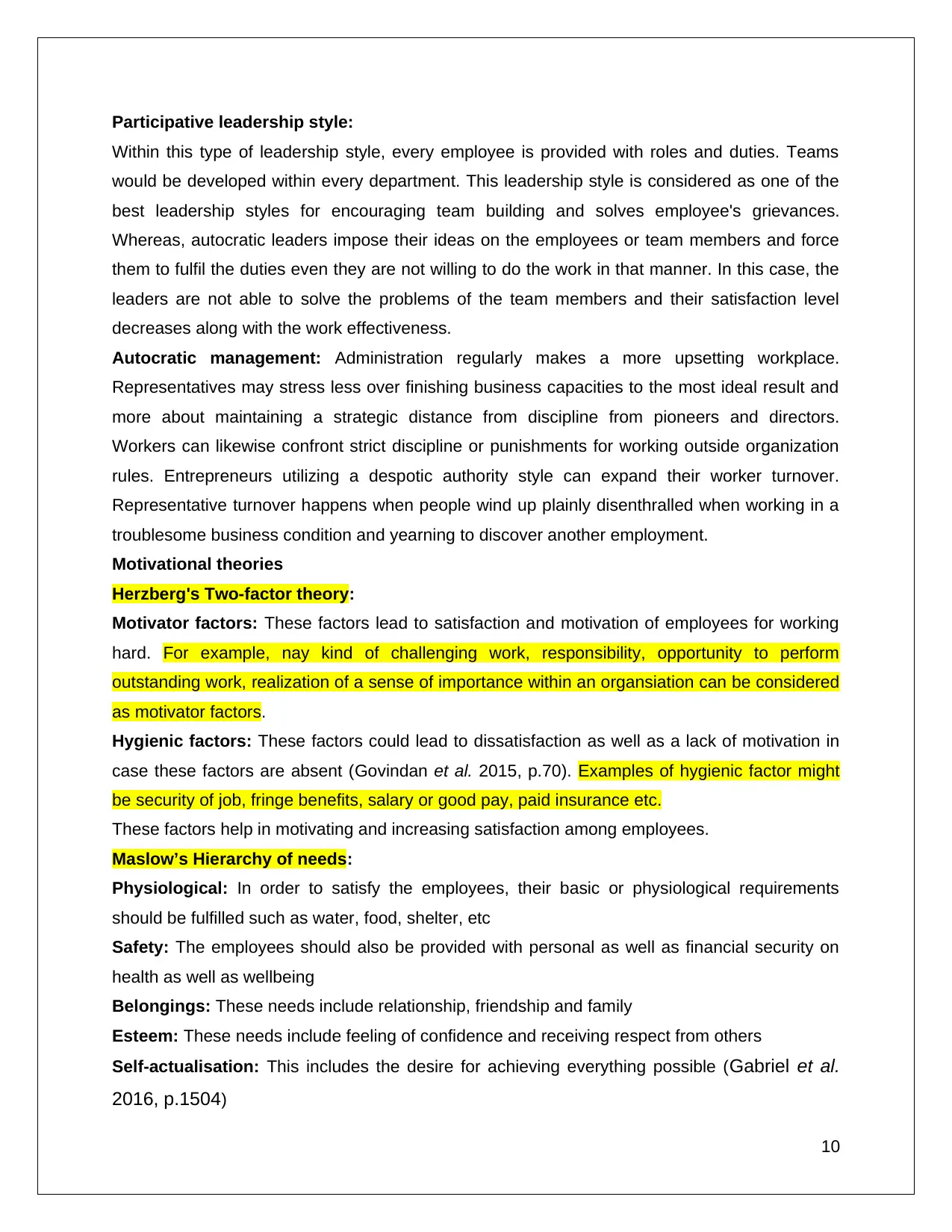
Participative leadership style:
Within this type of leadership style, every employee is provided with roles and duties. Teams
would be developed within every department. This leadership style is considered as one of the
best leadership styles for encouraging team building and solves employee's grievances.
Whereas, autocratic leaders impose their ideas on the employees or team members and force
them to fulfil the duties even they are not willing to do the work in that manner. In this case, the
leaders are not able to solve the problems of the team members and their satisfaction level
decreases along with the work effectiveness.
Autocratic management: Administration regularly makes a more upsetting workplace.
Representatives may stress less over finishing business capacities to the most ideal result and
more about maintaining a strategic distance from discipline from pioneers and directors.
Workers can likewise confront strict discipline or punishments for working outside organization
rules. Entrepreneurs utilizing a despotic authority style can expand their worker turnover.
Representative turnover happens when people wind up plainly disenthralled when working in a
troublesome business condition and yearning to discover another employment.
Motivational theories
Herzberg's Two-factor theory:
Motivator factors: These factors lead to satisfaction and motivation of employees for working
hard. For example, nay kind of challenging work, responsibility, opportunity to perform
outstanding work, realization of a sense of importance within an organsiation can be considered
as motivator factors.
Hygienic factors: These factors could lead to dissatisfaction as well as a lack of motivation in
case these factors are absent (Govindan et al. 2015, p.70). Examples of hygienic factor might
be security of job, fringe benefits, salary or good pay, paid insurance etc.
These factors help in motivating and increasing satisfaction among employees.
Maslow’s Hierarchy of needs:
Physiological: In order to satisfy the employees, their basic or physiological requirements
should be fulfilled such as water, food, shelter, etc
Safety: The employees should also be provided with personal as well as financial security on
health as well as wellbeing
Belongings: These needs include relationship, friendship and family
Esteem: These needs include feeling of confidence and receiving respect from others
Self-actualisation: This includes the desire for achieving everything possible (Gabriel et al.
2016, p.1504)
10
Within this type of leadership style, every employee is provided with roles and duties. Teams
would be developed within every department. This leadership style is considered as one of the
best leadership styles for encouraging team building and solves employee's grievances.
Whereas, autocratic leaders impose their ideas on the employees or team members and force
them to fulfil the duties even they are not willing to do the work in that manner. In this case, the
leaders are not able to solve the problems of the team members and their satisfaction level
decreases along with the work effectiveness.
Autocratic management: Administration regularly makes a more upsetting workplace.
Representatives may stress less over finishing business capacities to the most ideal result and
more about maintaining a strategic distance from discipline from pioneers and directors.
Workers can likewise confront strict discipline or punishments for working outside organization
rules. Entrepreneurs utilizing a despotic authority style can expand their worker turnover.
Representative turnover happens when people wind up plainly disenthralled when working in a
troublesome business condition and yearning to discover another employment.
Motivational theories
Herzberg's Two-factor theory:
Motivator factors: These factors lead to satisfaction and motivation of employees for working
hard. For example, nay kind of challenging work, responsibility, opportunity to perform
outstanding work, realization of a sense of importance within an organsiation can be considered
as motivator factors.
Hygienic factors: These factors could lead to dissatisfaction as well as a lack of motivation in
case these factors are absent (Govindan et al. 2015, p.70). Examples of hygienic factor might
be security of job, fringe benefits, salary or good pay, paid insurance etc.
These factors help in motivating and increasing satisfaction among employees.
Maslow’s Hierarchy of needs:
Physiological: In order to satisfy the employees, their basic or physiological requirements
should be fulfilled such as water, food, shelter, etc
Safety: The employees should also be provided with personal as well as financial security on
health as well as wellbeing
Belongings: These needs include relationship, friendship and family
Esteem: These needs include feeling of confidence and receiving respect from others
Self-actualisation: This includes the desire for achieving everything possible (Gabriel et al.
2016, p.1504)
10
Paraphrase This Document
Need a fresh take? Get an instant paraphrase of this document with our AI Paraphraser
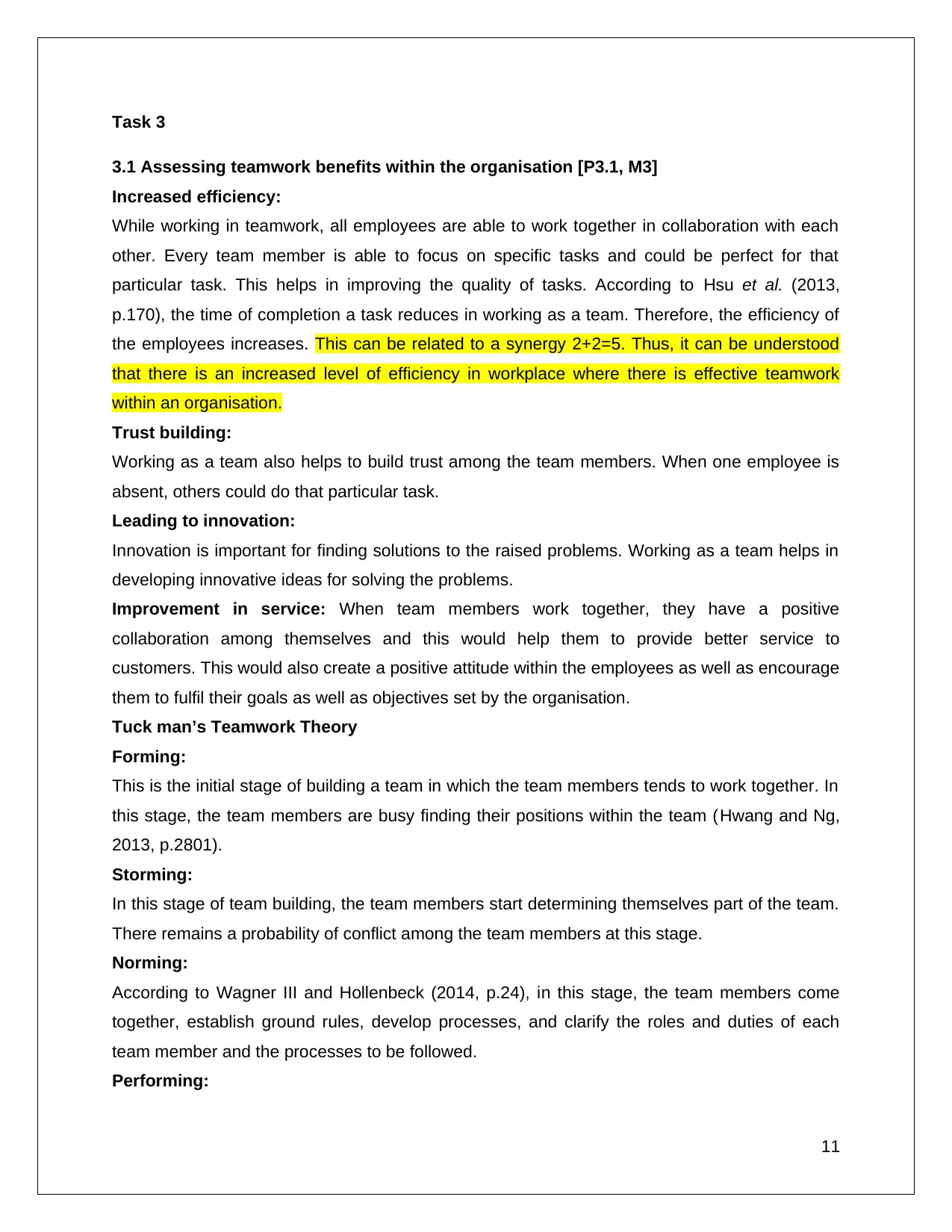
Task 3
3.1 Assessing teamwork benefits within the organisation [P3.1, M3]
Increased efficiency:
While working in teamwork, all employees are able to work together in collaboration with each
other. Every team member is able to focus on specific tasks and could be perfect for that
particular task. This helps in improving the quality of tasks. According to Hsu et al. (2013,
p.170), the time of completion a task reduces in working as a team. Therefore, the efficiency of
the employees increases. This can be related to a synergy 2+2=5. Thus, it can be understood
that there is an increased level of efficiency in workplace where there is effective teamwork
within an organisation.
Trust building:
Working as a team also helps to build trust among the team members. When one employee is
absent, others could do that particular task.
Leading to innovation:
Innovation is important for finding solutions to the raised problems. Working as a team helps in
developing innovative ideas for solving the problems.
Improvement in service: When team members work together, they have a positive
collaboration among themselves and this would help them to provide better service to
customers. This would also create a positive attitude within the employees as well as encourage
them to fulfil their goals as well as objectives set by the organisation.
Tuck man’s Teamwork Theory
Forming:
This is the initial stage of building a team in which the team members tends to work together. In
this stage, the team members are busy finding their positions within the team (Hwang and Ng,
2013, p.2801).
Storming:
In this stage of team building, the team members start determining themselves part of the team.
There remains a probability of conflict among the team members at this stage.
Norming:
According to Wagner III and Hollenbeck (2014, p.24), in this stage, the team members come
together, establish ground rules, develop processes, and clarify the roles and duties of each
team member and the processes to be followed.
Performing:
11
3.1 Assessing teamwork benefits within the organisation [P3.1, M3]
Increased efficiency:
While working in teamwork, all employees are able to work together in collaboration with each
other. Every team member is able to focus on specific tasks and could be perfect for that
particular task. This helps in improving the quality of tasks. According to Hsu et al. (2013,
p.170), the time of completion a task reduces in working as a team. Therefore, the efficiency of
the employees increases. This can be related to a synergy 2+2=5. Thus, it can be understood
that there is an increased level of efficiency in workplace where there is effective teamwork
within an organisation.
Trust building:
Working as a team also helps to build trust among the team members. When one employee is
absent, others could do that particular task.
Leading to innovation:
Innovation is important for finding solutions to the raised problems. Working as a team helps in
developing innovative ideas for solving the problems.
Improvement in service: When team members work together, they have a positive
collaboration among themselves and this would help them to provide better service to
customers. This would also create a positive attitude within the employees as well as encourage
them to fulfil their goals as well as objectives set by the organisation.
Tuck man’s Teamwork Theory
Forming:
This is the initial stage of building a team in which the team members tends to work together. In
this stage, the team members are busy finding their positions within the team (Hwang and Ng,
2013, p.2801).
Storming:
In this stage of team building, the team members start determining themselves part of the team.
There remains a probability of conflict among the team members at this stage.
Norming:
According to Wagner III and Hollenbeck (2014, p.24), in this stage, the team members come
together, establish ground rules, develop processes, and clarify the roles and duties of each
team member and the processes to be followed.
Performing:
11
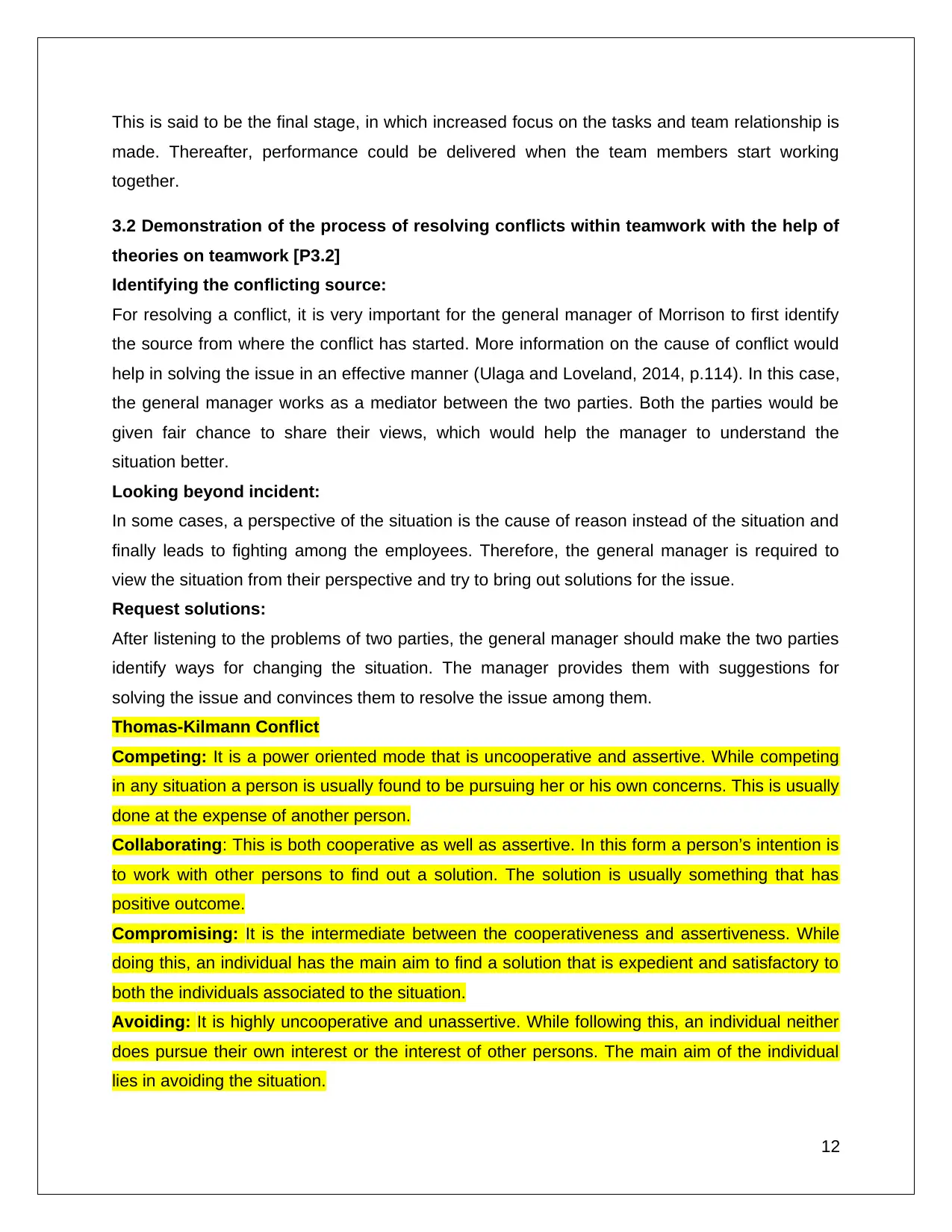
This is said to be the final stage, in which increased focus on the tasks and team relationship is
made. Thereafter, performance could be delivered when the team members start working
together.
3.2 Demonstration of the process of resolving conflicts within teamwork with the help of
theories on teamwork [P3.2]
Identifying the conflicting source:
For resolving a conflict, it is very important for the general manager of Morrison to first identify
the source from where the conflict has started. More information on the cause of conflict would
help in solving the issue in an effective manner (Ulaga and Loveland, 2014, p.114). In this case,
the general manager works as a mediator between the two parties. Both the parties would be
given fair chance to share their views, which would help the manager to understand the
situation better.
Looking beyond incident:
In some cases, a perspective of the situation is the cause of reason instead of the situation and
finally leads to fighting among the employees. Therefore, the general manager is required to
view the situation from their perspective and try to bring out solutions for the issue.
Request solutions:
After listening to the problems of two parties, the general manager should make the two parties
identify ways for changing the situation. The manager provides them with suggestions for
solving the issue and convinces them to resolve the issue among them.
Thomas-Kilmann Conflict
Competing: It is a power oriented mode that is uncooperative and assertive. While competing
in any situation a person is usually found to be pursuing her or his own concerns. This is usually
done at the expense of another person.
Collaborating: This is both cooperative as well as assertive. In this form a person’s intention is
to work with other persons to find out a solution. The solution is usually something that has
positive outcome.
Compromising: It is the intermediate between the cooperativeness and assertiveness. While
doing this, an individual has the main aim to find a solution that is expedient and satisfactory to
both the individuals associated to the situation.
Avoiding: It is highly uncooperative and unassertive. While following this, an individual neither
does pursue their own interest or the interest of other persons. The main aim of the individual
lies in avoiding the situation.
12
made. Thereafter, performance could be delivered when the team members start working
together.
3.2 Demonstration of the process of resolving conflicts within teamwork with the help of
theories on teamwork [P3.2]
Identifying the conflicting source:
For resolving a conflict, it is very important for the general manager of Morrison to first identify
the source from where the conflict has started. More information on the cause of conflict would
help in solving the issue in an effective manner (Ulaga and Loveland, 2014, p.114). In this case,
the general manager works as a mediator between the two parties. Both the parties would be
given fair chance to share their views, which would help the manager to understand the
situation better.
Looking beyond incident:
In some cases, a perspective of the situation is the cause of reason instead of the situation and
finally leads to fighting among the employees. Therefore, the general manager is required to
view the situation from their perspective and try to bring out solutions for the issue.
Request solutions:
After listening to the problems of two parties, the general manager should make the two parties
identify ways for changing the situation. The manager provides them with suggestions for
solving the issue and convinces them to resolve the issue among them.
Thomas-Kilmann Conflict
Competing: It is a power oriented mode that is uncooperative and assertive. While competing
in any situation a person is usually found to be pursuing her or his own concerns. This is usually
done at the expense of another person.
Collaborating: This is both cooperative as well as assertive. In this form a person’s intention is
to work with other persons to find out a solution. The solution is usually something that has
positive outcome.
Compromising: It is the intermediate between the cooperativeness and assertiveness. While
doing this, an individual has the main aim to find a solution that is expedient and satisfactory to
both the individuals associated to the situation.
Avoiding: It is highly uncooperative and unassertive. While following this, an individual neither
does pursue their own interest or the interest of other persons. The main aim of the individual
lies in avoiding the situation.
12
⊘ This is a preview!⊘
Do you want full access?
Subscribe today to unlock all pages.

Trusted by 1+ million students worldwide
1 out of 18
Related Documents
Your All-in-One AI-Powered Toolkit for Academic Success.
+13062052269
info@desklib.com
Available 24*7 on WhatsApp / Email
![[object Object]](/_next/static/media/star-bottom.7253800d.svg)
Unlock your academic potential
Copyright © 2020–2025 A2Z Services. All Rights Reserved. Developed and managed by ZUCOL.





